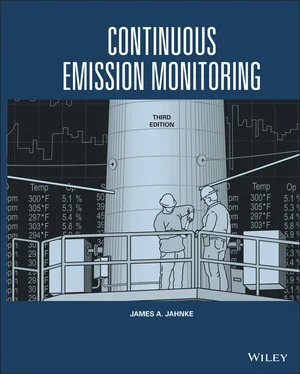James A. Jahnke - Continuous Emission Monitoring
Здесь есть возможность читать онлайн «James A. Jahnke - Continuous Emission Monitoring» — ознакомительный отрывок электронной книги совершенно бесплатно, а после прочтения отрывка купить полную версию. В некоторых случаях можно слушать аудио, скачать через торрент в формате fb2 и присутствует краткое содержание. Жанр: unrecognised, на английском языке. Описание произведения, (предисловие) а так же отзывы посетителей доступны на портале библиотеки ЛибКат.
- Название:Continuous Emission Monitoring
- Автор:
- Жанр:
- Год:неизвестен
- ISBN:нет данных
- Рейтинг книги:4 / 5. Голосов: 1
-
Избранное:Добавить в избранное
- Отзывы:
-
Ваша оценка:
- 80
- 1
- 2
- 3
- 4
- 5
Continuous Emission Monitoring: краткое содержание, описание и аннотация
Предлагаем к чтению аннотацию, описание, краткое содержание или предисловие (зависит от того, что написал сам автор книги «Continuous Emission Monitoring»). Если вы не нашли необходимую информацию о книге — напишите в комментариях, мы постараемся отыскать её.
The new edition of the only single-volume reference on both the regulatory and technical aspects of U.S. and international continuous emission monitoring (CEM) systems Continuous Emission Monitoring
Continuous Emission Monitoring:
Continuous Emission Monitoring, Third Edition
Continuous Emission Monitoring — читать онлайн ознакомительный отрывок
Ниже представлен текст книги, разбитый по страницам. Система сохранения места последней прочитанной страницы, позволяет с удобством читать онлайн бесплатно книгу «Continuous Emission Monitoring», без необходимости каждый раз заново искать на чём Вы остановились. Поставьте закладку, и сможете в любой момент перейти на страницу, на которой закончили чтение.
Интервал:
Закладка:
A value for B wscan be obtained by either installing some type of moisture monitor, using a value obtained by manual stack testing, or by estimating a value based on process parameters. Using a moisture analyzer is the most straightforward approach; however, this adds another analyzer to the CEM system. A common technique is to measure oxygen on both a wet and a dry basis and using the results to compute B ws. Also, various calculation approaches have been proposed (Aldina 1985; McGowan 1976) that involve the manipulation of combustion source F factors. But frequently, a moisture value obtained from manual stack test measurements is set as a constant factor to make the appropriate corrections. This approach assumes that variation in the value will be small under normal source operating conditions.
It is not necessary to convert dilution measurements into a dry basis if emission measurements are to be reported on an actual or wet basis. If the emissions are to be reported in terms of a pollutant mass rate (pollutant mass/unit time) as in the acid rain program, the wet basis measurement can be used directly. Also, if emissions are reported in terms of ng/joule or lbs/million Btu, a moisture correction is not needed if CO 2is monitored along with the pollutant. This is due to the form of the F factor equation used to calculate emission rate in ng/Joule or lbs/million Btu as discussed earlier (see Equation 3‐10). When CO 2is monitored as a diluent and the F cfactor equation is used, moisture content cancels out in the ratio between the pollutant concentration and CO 2concentration. This is also discussed in EPA Test Method 19 (U.S. EPA 2020b).
Lastly, one should be aware of inadequacies associated with the use of dry calibration gases to check the performance of wet systems. Cylinder gases used for calibration or audit purposes are dry gases, containing no water. The molecular weight of a dry gas used to establish the calibration of a dilution system will be different than the molecular weight of a flue gas containing percent levels of moisture. As discussed earlier, this will affect the dilution ratio and introduce bias into the measurement. Also, some analyzers are subject to interference by water vapor. Here, a dry calibration gas may not truly establish the calibration function for the analyzer and the wet flue gas measurements will be in error. Additionally, water can adsorb onto sample tubing and internal instrument surfaces and subsequently reduce the adsorption of other gases such as volatile organic compounds (Peeler et al. 1997). Daily calibration with dry gases can disrupt this effect and cause some disequilibrium in the measurements for a period of time after calibration.
SAMPLING INTERFACE/MONITOR CALIBRATION
The entire extractive system sampling system and gas analysis system must be capable of being calibrated as a unit. In the design of the system, calibration gases should be able to be injected as close as possible at the probe – a recommendation made in fact by the EPA in its Appendix F quality assurance requirements and a requirement for cylinder gas audits and linearity checks. This is necessary to check for leaks or other operational problems in the system. In calibrating source‐level‐extractive systems, the analyzer should be calibrated at the same gas flow rate, pressure, temperature, and operating procedures that are used in monitoring the stack gas. In calibrating dilution systems, the calibration gas must enter the system before the critical orifice. Flooding the coarse filter or dilution probe with calibration gas at the inlet or using a check valve that allows calibration gas injection directly behind the coarse filter are the best methods for performing this check (Reynolds 1989). If the system is not pressurized by the calibration gas, this method can be used to determine if leaks, blockage, or gas adsorption are occurring in the system.
The system should also be capable of checking the calibration directly at the analyzer. A comparison between instrument readings from a probe calibration check and an analyzer calibration check is frequently useful in system troubleshooting.
The calibration gases are usually injected automatically every 24 hours although some operators prefer to perform calibration checks manually so that the system can be watched more closely.
EXTRACTIVE SYSTEM COMPONENTS AND ACCESSORIES
The design of an extractive system involves considering more than piecing together a probe, pump, and a conditioning or dilution system. The task is more complex since decisions must be made on at least the following minimum components:
1 Sample probe: construction and composition
2 Probe blowback: design and frequency
3 Sample line: composition, length, and diameter
4 Valves and fittings: construction and composition
5 Pressure and vacuum meters: quality
6 Moisture conditioning system: refrigerated, dilution, capacity, design, and construction
7 Filters: coarse, fine, or coalescing
8 Pumps: capacity, type, and quality
9 CEM shelters or cabinets: location, shelter HVAC requirements, enclosed space safety considerations, temperature stability
10 System controller: programmable logic controllers, datalogger, or microprocessor to sequence and control automatic functions
11 Electrical support: fuses, circuit breakers, regulating equipment, and uninterruptible power supplies (UPS)
12 Calibration gases: location, injection point, tubing requirements, regulators, and manifold, certified gases as appropriate, cylinder gas cabinet or weather overhang, cabinet heater/air conditioning as appropriate
13 Automatic calibration system: valves, injection sequencing, interconnections with the DAS and/or DCS
Issues associated with many of these components are discussed in further detail by McNulty et al. (1974) and Podlenski et al. (1984). The resistance of different materials to acid gases, flow rate, condensation requirements is particularly addressed.
Extractive CEM systems are most commonly housed in a temperature‐controlled room or a modular shelter. This adds significantly to the expense of a CEM system, but it does provide a centralized location to conduct system operations. To reduce costs, system manufacturers can also incorporate systems in temperature‐controlled National Electrical Manufacturers Association (NEMA) enclosures, a common practice in process monitoring applications. Alternatively, by close‐coupling the system to the stack, costs associated with sampling line and shelter are essentially eliminated.
To construct a working extractive system that delivers a representative sample to the gas analyzers is not something that can be done without experience, requiring an understanding of the interaction of gases, temperature, and materials. This experience is most often gained through trial and error and may require time to acquire.
MINI‐SYSTEMS
Compact miniature CEM systems advertised as mini‐systems or microsystems can be obtained at costs less than one quarter of the cost of traditional CEM systems that use discrete analyzers mounted in an instrument rack located in a temperature‐controlled shelter. Although these systems are often designed for relatively clean or specialized applications, such as gas turbine NO xmonitoring, there are few technical barriers limiting system miniaturization for wider use. Increasing miniaturization in sensor design and microprocessor systems enables the compact construction of entire CEM systems that include extractive components, conditioning systems, and analytical systems (Josseau 2009; Koch et al. 2007). A single microprocessor can provide both system and analyzer control for multiple gas sensors. RS232‐RS485 outputs allow direct input into the plant distributive control system or environmental manager's computer.
Читать дальшеИнтервал:
Закладка:
Похожие книги на «Continuous Emission Monitoring»
Представляем Вашему вниманию похожие книги на «Continuous Emission Monitoring» списком для выбора. Мы отобрали схожую по названию и смыслу литературу в надежде предоставить читателям больше вариантов отыскать новые, интересные, ещё непрочитанные произведения.
Обсуждение, отзывы о книге «Continuous Emission Monitoring» и просто собственные мнения читателей. Оставьте ваши комментарии, напишите, что Вы думаете о произведении, его смысле или главных героях. Укажите что конкретно понравилось, а что нет, и почему Вы так считаете.












